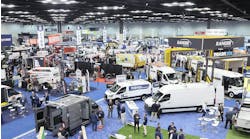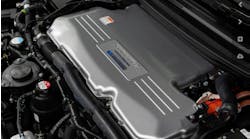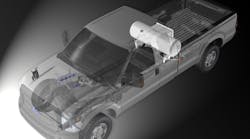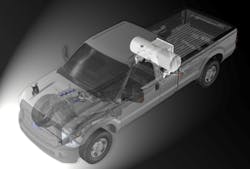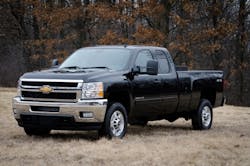For the automotive industry, the fall season means new vehicle models arrive at dealerships across the nation. It’s time for contractors to see what the new trucks and vans have to offer. With 2013 models, automotive companies are offering contractors plenty of cargo space and low gas mileage, plus, there are a variety of alternative-fuel vehicles on the market too.
The Nissan NV200 Compact Cargo Van is joining the growing lineup of Nissan Commercial Vehicles in spring of 2013, and contractors can currently place orders with any Nissan commercial vehicle dealer.
“There is an increasing need for a ‘right-sized’ van that optimizes cargo space while offering the best possible fuel economy and an affordable price — the exact sweet spots of the innovative new Nissan NV200,” says Joe Castelli, vice president, Nissan Commercial Vehicles and Fleet. “The Nissan NV200 is designed as a durable work tool, with features such as the seating wear patches, low-effort sliding side doors and wide-opening rear doors. And since we fully understand how vans like this are used in business, it’s also a very pleasant vehicle to drive and use as a mobile office.”
The NV200 offers a large cargo capacity of 123 cubic feet with a small exterior footprint. Unique for North America, the NV200 body has been extended 7.9 inches (200 mm). This longer body length offers additional cargo carrying capability. Measuring just 186.2 inches in overall length, on a 115.2-inch wheelbase, NV200 is highly maneuverable in traffic and negotiating city parking spaces. Yet it allows for a 1,500-pound (estimated) maximum payload. The cargo area dimension between the efficiently designed wheelhouses allows for loading standard U.S. 40x48-inch pallets. Added utility is provided by the standard integrated mounting points, which allow installation of racks and shelves without drilling into the sidewalls, and six available floor mounted cargo hooks in the cargo area. Additional information about the NV200 Compact Cargo Van and other Nissan vehicles is available at: www.nissancommercialvehicles.com.
RAM also offers trucks and vans for the contractor. The 2013 RAM C/V Tradesman is a cargo van featuring a flat aluminum load floor or Best-In-Class 155.5 cubic feet maximum cargo capacity with the available load floor with convenient in-floor storage bins. It features a 3.6L Pentastar engine with RAM’s Extended Maintenance Cycle. Also available is the 2013 RAM 1500 pickup truck. Additional information about RAM vehicles is available at: http://www.ramtrucks.com/en/.
The 2013 Ford Transit Connect is another vehicle contractors should consider. This van features class-leading fuel economy combined with 7,500-mile service intervals and a 97,500-mile tune-up interval, and up to 129.6 cubic feet of cargo volume behind the front seats with a load floor more than six feet long and maximum payload up to 1,600 pounds. Additional information about the Ford Transit Connect is available at: http://www.ford.com/trucks/transitconnect/.
Last year, Wilo USA LLC purchased three modified Ford Transit Connects that contain a pull-out display of Wilo products for its Street Fleet. This year an order was placed to add three more Transit Connects to the fleet in 2013.
According to Mark D’Agostino, president and CEO of Wilo USA LLC, this vehicle is great if you are a contractor working in urban areas.
“When we do training in NYC, downtown Chicago, downtown Los Angeles, etc., you can park in regular sized parking spaces as well as compact spaces, and it’s easy to get through intersections,” says D’Agostino. “From a contractor’s perspective — and I spent a lot of years as a contractor — I was in big, full-sized vans and it can be challenging to park them and get them around in an urban area. We did a two week run through D.C. this year and we think that was our greatest advantage. You could bring it anywhere. You can even get it through an alley. You can do things with it you can’t do with a full-size van.”
D’Agostino points out that an aftermarket install of an upgrade for suspension was done on the Transit Connects.
“Kits were about $500 and the installation was about $800,” says D’Agostino. “You have a usable payload of 1,500 pounds. With the addition of the suspension units we can add 750 pounds to it. So now they can carry 2,250 pounds. This worked great for us.”
Besides the Transit Connect, Ford has a variety of pickup trucks to choose from. The 2013 Ford F-150 has a full payload of best-in-class features, including horsepower, torque, towing and payload capacity for most engine/body configurations. Additional information is available at: http://www.ford.com/trucks/f150/. Also available are Ford F-Series Super Duty pickup trucks. Information about the Super Duty pickup trucks is available at: http://www.ford.com/commercial-trucks/superduty-commercial/.
Another truck contractors can consider is the Toyota Tundra, www.toyota.com/tundra/, available in three models: the Tundra CrewMax, Tundra Double Cab and Tundra Regular Cab.
For the contractor looking for a cargo van, The Freightliner Sprinter, www.freightlinersprinterusa.com/, is a possibility. The Sprinter Cargo Van provides a maximum payload up to 5,415 pounds, an interior height of 78.22 inches and maximum cargo volume up to 547 cubic feet.
Propane, bi-fuel options
Contractors should also consider the Roush CleanTech liquid propane autogas Ford F-250 and F-350. Roush CleanTech, based in Livonia, Mich., offers dedicated liquid propane autogas fuel systems for a variety of light- and medium-duty Ford vans and trucks.
“We offer even more products than we did just a year ago,” says Todd Mouw, vice president of sales and marketing for Roush CleanTech. “We have the new F250/350 pickup truck with the 6.2 liter engine.”
According to Mouw, Roush CleanTech now has hard data from end users, showing what the benefits of propane are.
“Customers are now seeing that other fleets are using it, that it works, that it’s clean, and the savings are there,” says Mouw. “That is what is fueling the growth of propane autogas. I think you are starting to see why propane and natural gas are having such success since there is a big return on investment.”
ARS/Rescue Rooter hasbeen using propane autogas cargo and cutaway vans in Los Angeles and Houston since summer 2011. They started with 21 vehicles, and have plans to continue increasing that number in more markets.
“Right now we have 22 propane vehicles from Roush CleanTech,” says Kevin O’Donnell, director of purchasing and fleet at ARS/Rescue Rooter. “We went with Roush and we are obviously saving money on fuel and the maintenance on vehicles is reduced too, and we put in a propane filling station on site where we have 20 of the vehicles on location.”
Even a contractor with a handful of vehicles should consider propane fuel systems.
“Propane autogas works for large fleets and also the contractor with four or five vans,” says Mouw. “It works for them because it’s a small cost for a fueling station. So an owner of a contracting company can put in that fueling station and can fuel his vans with it. Once the station is in they can reap the economic benefits of it. They can also use the existing propane autogas public refueling infrastructure across the nation.”
Additional information about ROUSH CleanTech liquid propane autogas Ford F-250 and F-350 trucks is available at: http://www.roushcleantech.com.
Other vehicle options for contractors are the Chevrolet and GMC extended cab heavy-duty pickup trucks with a bi-fuel option. The pickups, which run on compressed natural gas (CNG) and gasoline, have a Vortec 6.0L V8 engine that transitions between the two fuel systems. A single light-weight Type 3 tank in the bed maximizes available payload and bed space. The Silverado HD and Sierra 2500 HD offer customers fueling flexibility with a combined CNG and gasoline range of more than 650 miles. The pickups are available in standard and long-box, two-or-four-wheel drive in the extended cab models, offering customization for specific needs.
Truck shows, associations
There are many ways contractors can stay up-to-date on new vehicle models and automotive technologies. One of the best ways to stay current on work trucks is to go to The Work Truck Show 2013 in Indianapolis, March 6-8.
In conjunction with The Work Truck Show there will be a Fleet Management Symposium for fleet managers in all industries, including construction. The day-and-a-half symposium,March 5-6, has more than 60 educational sessions covering industry topics. The Green Truck Summit, which is known for offering cutting-edge solutions, will be held in conjunction with The Work Truck Show.
While at The Work Truck Show attendees can explore the newest truck chassis, bodies, equipment and components from more than 550 exhibiting companies. There will also be the Green Truck Ride-and-Drive that attendees can participate in. A fixture of The Work Truck Show since 2007, the Green Truck Ride-and-Drive gives attendees the opportunity to experience energy-efficient vehicles firsthand. This year’s event includes a wide range of environmentally friendly drive systems. Some of the vehicles will also feature lightweight and aerodynamic technologies that further reduce the vehicle’s fuel consumption.
“Driving a truck under real-world conditions provides insights into the vehicle that you can’t get any other way,” says Bob Johnson, fleet relations director at NTEA — The Association for the Work Truck Industry. “You can experience for yourself the vehicle’s handling characteristics, sounds, user-friendliness and more. If you’re interested in green vehicles, be sure to allow time in your show schedule for the Ride-and-Drive.”
Access to the Green Truck Ride-and-Drive is included with Work Truck Show registration. Attendees sign up on the show floor for the vehicles they want to drive on a first-come, first-served basis. The Ride-and-Drive course covers city streets to provide a realistic driving experience. Visit www.ntea.com/worktruckshow/greenproductsandprograms to learn more about the Green Truck Ride-and-Drive, Green Truck Summit and other Work Truck Show 2013 green products and programs.
Another resource is the Green Truck Association (GTA), an affiliate division of the NTEA. Its primary mission is to educate all segments of the vocational truck equipment industry (manufacturers, suppliers and end users) in all aspects of green truck technologies and alternative fuels.
“The GTA is technical in nature and strives to bring all segments of the industry from OEMs to the end users together to understand the benefits and realities of deploying these technologies and fuels,” says Johnson. “GTA members get access to NTEAs and GTS technical staff for support. One of the concepts the GTA promotes is that understanding your drive and duty cycle is key and that building a lifecycle cost model is at the heart of making a good decision.”
Available on Contractor’s website is the article, “You Can’t Escape Technology: Take Advantage of It,” by Bob Johnson, director of fleet relations, NTEA. The article covers how regulatory requirements governing fuel economy, emissions and safety have turned today’s work trucks into rolling computers and how managers need to evaluate how they maintain and manger their vehicles.
